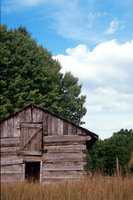 | Back to e-WV
| Back to e-WV
 The West Virginia Encyclopedia
The West Virginia Encyclopedia
 | Back to e-WV
| Back to e-WV
 The West Virginia Encyclopedia
The West Virginia Encyclopedia

West Virginia barns present a wide variety of type, shape, style, and materials. The oldest barn styles, those built during the frontier period, are a visual historic record of westward expansion. West Virginia’s earliest settlers, many of whom came to the South Branch of the Potomac, the Greenbrier, and other river valleys, constructed barns that show stylistic evidence of their builders’ ethnic origins.
Three general barn types may be observed among the older barns along the eastern side of the state: the double-crib log barn, the ‘‘Pennsylvania’’ or ‘‘German bank barn,’’ and the ‘‘English barn.’’ Early settlers favored log barns because of the ease with which they could obtain the materials. As sawn boards became available, large, timber-framed bank barns, with their multi-level entrances, dotted the countryside in areas where people of German descent settled. Rectangular framed English-style barns may also be found, reflecting that ethnicity’s place in early settlement. These barn types did not die out after the pioneer period, and many fine log barns were constructed until the early to mid-20th century. As one travels from east to west in the state, greater variation with less adherence to classic style may be observed in the structural aspects and overall shape of barns. Several 19th-century round barns have endured to the present.
West Virginia hill farms are likely to have more numerous, smaller barns than the ‘‘great barns’’ found in the larger river bottoms of the state, the gentler terrain of the Eastern Panhandle, and the western Ohio Valley. Like geography, age contributes to marked differences in styles because of newer construction materials. Traditional log, lumber, and stone components gave way to concrete, brick, blocks, and metal for foundations and walls, while asphalt-shingled and tin roofs replaced the more traditional wooden shingles or slate. Modern barns display more windows, owing to the greater availability and reasonable cost of glass, whereas older barns simply had hinged openings.
Barns are utilitarian buildings. Their shape and usefulness are determined by their function. Hay barns, tobacco barns, dairy barns, sheepfolds, and horse stables present varied reasons for design and shape. Today, due to advanced farming techniques, older barns may not be used in ways for which they were intended. As more and more people abandon agrarian lifestyles, obsolete barns simply become symbols of country life, while they are put to other, non-agrarian uses. Barns are now recognized American icons, and their presence is important for those who identify with our country’s rural past.
Written by Gerald Milnes
Montell, Lynwood W. & Michael L. Morse. Kentucky Folk Architecture. Lexington: University Press of Kentucky, 1976.
Noble, Allen G. The Old Barn Book: A Field Guide to North American Barns and Other Farm Structures. New Brunswick: Rutgers University Press, 1996.
Biola, Heather R. Barn Builder: The Working Wisdom of Lawson Kimbrew. Goldenseal, (Winter 1987).
Milnes, Gerald C. The Barns of Pendleton County. Goldenseal, (Spring 1998).
Shultz, Leroy G. The Barns of West Virginia. Goldenseal, (April-September 1978).